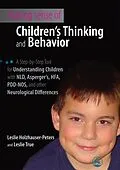Making Sense of Children's Thinking and Behavior offers parents and professionals a tool for understanding children with neurological differences. These children have an atypical view of the world, unique to their particular disability, which can make their behavior confusing and, at times, challenging. Often, the child's actions are misunderstood and, consequently, they are unfairly punished.
An individualized approach to understanding a child's thought processes can help to resolve these problems. The authors' Systematic Tool for Analyzing Thinking (STAT) offers such an approach. It provides a step-by-step method for understanding a child's behavior by revealing the thought processes behind it. By viewing a situation from the child's perspective, the root of the problem can be identified and one can then effectively address the difficult behavior. Case studies are used to describe the twelve common deficit areas, demonstrating to the reader how to apply the STAT in everyday situations.
This practical book is an invaluable resource for parents and professionals working with children with NLD, Asperger's, HFA, PDD-NOS, and other neurological differences.
Autorentext
Leslie Holzhauser-Peters has thirty years of experience working in the public school setting in the fields of Special Education and General Education. She has worked as a Speech-Language Pathologist, Supervisor and Curriculum Consultant and has authored several publications. Over the past few years she has acted both as an advocate and speech language pathologist to her co-author's son Joshua. Leslie True is the mother of three sons. The oldest, Joshua, has been diagnosed with a NLD. She has devoted years to actively campaigning on Joshua's behalf and, for the past year, has worked as an instructional aide for a child diagnosed with a NLD.
Inhalt
Contents: About the Authors. Introduction. 1. The Systematic Tool to Analyze Thinking (STAT). 2. Abstract Language. 3. Motor. 4. Sensory. 5. Spatial Orientation. 6. Control/Consistency. 7. Thinking About Others Thinking (Theory of Mind). 8. Social Communication. 9. Emotions. 10. Mental Flexibility. 11. Impulsivity. 12. Executive Functions.13. Anxiety. 14. Believe. Appendix I Summary of the Systematic Tool to Analyze Thinking. Appendix II The Systematic Tool to Analyze Thinking: full version. Appendix III Story Locator. Index.
